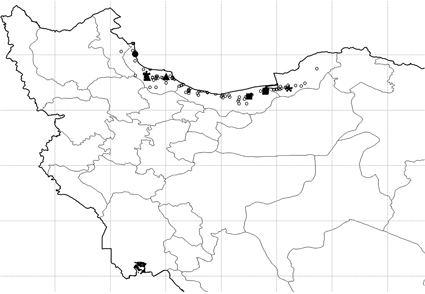Abstract
Earthworms are the most important soil invertebrates worldwide, in terms of biomass and effects on soil processes. In this study, 21 earthworm species, including four new records were identified from Caspian Hyrcanian Forests (North of Iran). Four species; Criodrilus lacuum, Lumbricus rubellus, Metaphire californica, and Octodrilus transpadanus and the family Criodrilidae are reported for the first time. Previous studies have identified 31 earthworm species belonging to 14 genera and three families (Lumbricidae, Acanthodrilidae, and Megascolecidae) in Iran; therefore, these new records increase the number of earthworm species to a total of 35.
References
Bayranvand, M., Kooch, Y. & Rey, A. (2017) Earthworm population and microbial activity temporal dynamics in a Caspian Hyrcanian mixed forest. European Journal of Forest Research, 136 (3), 447–456. https://doi.org/10.1007/s10342-017-1044-5
Blakemore, R.J. (2003) Japanese earthworms (Annelida: Oligochaeta): a review and checklist of species. Organisms Diversity & Evolution, 3, 241–244. https://doi.org/10.1078/1439-6092-00082
Blakemore, R.J. (2008a) Review of Criodrilidae (Annelida: Oligochaeta) including Biwadrilus from Japan. Opuscula Zoologica Budapest, 37, 11–22.
Blakemore, R.J. (2008b) Cosmopolitan earthworms—an Eco-Taxonomic Guide to the Species. 3rd Edition. Verm Ecology, Yokohama, 757 pp.
Bozorgi, F., Seiedy, M., Malek, M., Aira, M., Pérez-Losada, M. & Domínguez, J. (2019) Multigene phylogeny reveals a new Iranian earthworm genus (Lumbricidae: Philomontanus) with three new species. PLoS ONE, 14 (1), e0208904. https://doi.org/10.1371/journal.pone.0208904
Chang, C.H., Snyder, B.A. & Szlavecz, K. (2016) Asian pheretimoid earthworms in North America north of Mexico: An illustrated key to the genera Amynthas, Metaphire, Pithemera, and Polypheretima (Clitellata: Megascolecidae). Zootaxa, 4179 (3), 495–529. https://doi.org/10.11646/zootaxa.4179.3.7
Csuzdi, C. & Zicsi, A. (2003) Earthworms of Hungary (Annelida: Oligochaeta, Lumbricidae). Hungarian Natural History Museum, Budapest, 278 pp.
Darwin, Ch. (1881) The formation of vegetable mould through the action of worms. J. Murray, London, 326 pp. https://doi.org/10.5962/bhl.title.107559
Ezzatpanah, S., Latif, R., Malek, M. & Salehi, H. (2010) Earthworm fauna of the western Mazandaran Province Iran (Oligochaeta: Lumbricidae, Megascolecidae). Zoology in the Middle East, 51 (2), 67–74. https://doi.org/10.1080/09397140.2010.10638459
Farhadi, Z., Malek, M. & Elahi, E. (2013) Review of the earthworm fauna of Iran with emphasis on Kohgiluyeh & Boyer-Ahmad Province. Zootaxa, 3670 (4), 440–448. https://doi.org/10.11646/zootaxa.3670.4.2
Latif, R., Ezzatpanah, S., Malek, M. & Parsa, H. (2009) Earthworms of the Central Elburz Mountain, Iran. Iranian Journal of Animal Biosystematics, 5 (2), 1–15. https://doi.org/10.22067/IJAB.V5I2.3332
Latif, R., Malek, M. & Csuzdi, C. (2017) New earthworm records from the Central Zagros Mountain, Iran with description of a new species. North-Western Journal of Zoology, 13 (2), 326–336.
Mirmonsef, H., Malek, M. & Latif, R. (2011) The earthworm fauna of Tehran Province, Iran: an ecological characterization. Iranian Journal of Animal Biosystematics, 7 (2), 89–97. https://doi.org/10.22067/ijab.v7i2.25510
Mýsýrlýoðlu, M., Valchovski, H. & Reynolds, J.W. (2019) Updated list of earthworms (Clitellata, Megadrili) from Turkey. Megadrilogica, 24 (8), 99–106.
Omodeo, P. (1956) Oligocheti dell’Indochina e del Mediterraneo Orientale. Memorie del Museo Civico di Storia Naturale di Verona, 5, 321–336.
Omrani, G.A. (1973) Bodenzoologische Untersuchungen über Regenwürmer im Zentral-und Nordiran. Doctoral dissertation, Justus Liebig-Universität, Gießen, Hesse, 159 pp.
Paymaneh, Z., Sarcheshmehpour, M., Askari Hesni, M. & James, S.W. (2018) Earthworms (Oligochaeta) of Southeast Iran with two new records. Zoology and Ecology, 28 (4), 412–417. https://doi.org/10.1080/21658005.2018.1544701
Peh, K.S.H., Corlett, R.T. & Bergeron, Y. (2015) Routledge handbook of forest ecology. Routledge, London, 656 pp. https://doi.org/10.4324/9781315818290
Reynolds, J.W. & Mýsýrlýoðlu, I.M. (2018) Preliminary Key to Turkish Megadriles (Annelida, Clitellata, Oligochaeta) Based on External Characters, Insofar as Possible. Megadrilogica, 23 (11), 141–160.
Sancholi, N., Roohi Aminjan, A., Latif, R., Sarabandi, V. & Riki, A. (2019) Earthworms from northern parts of Sistan and Balouchestan Province, Iran (Oligochaeta, Lumbricidae). Iranian Journal of Animal Biosystematics, 15 (2), 147–156. https://doi.org/ 10.22067/ijab.v15i2.81039
Sims, R.W. & Gerard, B.M. (1999) Earthworms: notes for the identification of British species. Linnean Society of London and the Estuarine and Coastal Sciences Association by Field Studies Council, Montford Bridge, Shrewsbury, 169 pp.
Zohary, M. (1973) Geobotanical foundations of the Middle East. Vol. 1. Gustav Fischer Verlag, Stuttgart, 340 pp.


